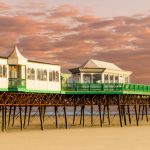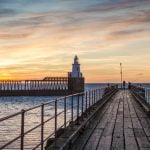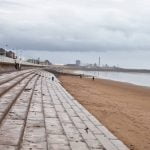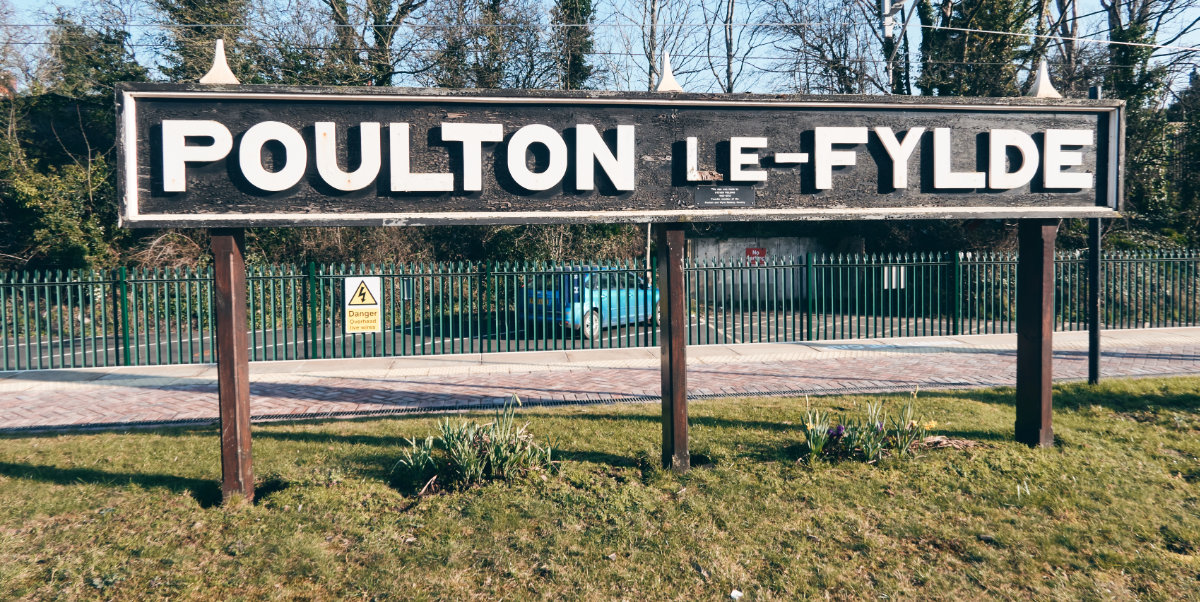
Found on the coastal plains of Fylde, Poulton is a seaside town set in an area of the coast famous for both wrecking ships and sunbathing. It has windmills, a proximity to a certain Pleasure Beach, and attracts thousands of tourists each year for the sun, sea, and the view out towards Ireland. This is exactly the red-and-yellow striped windbreaker, beach hut-filled, sand-in-your-jam style town you want if you are seeking new seaside memories. If the aim is to take a break in Britain that ticks all the holiday boxes, Poulton-le-Fylde could be it.
Let us learn all about this astonishing town.
The Early History of Poulton-le-Fylde
The town’s history starts with the Setantii tribe, who occupied the land here when the Romans invaded.
Around 10,000 BC there probably were not many people in Poulton. However, there was plenty of deer. Back in 1970, the town made international headlines when archaeologists discovered the fully intact remains of the Poulton stag. Not only did the 12,000-year-old skeleton come completely intact, but you could also see the barbs of hunting arrows in its bones. This indicates that there were hunters here 12,000 years ago. This was a historic discovery because these stags do not exist in the UK, they exist in the Ural mountains of Russia. This stag was the first evidence that the land masses shared a connection. The elk is still on display in the Harris Museum in Preston.
The Romans had a small fortlet about 15 miles from town. Ptolemy of Alexandria may have mentioned it, but later sources guess the site he mentioned is in Cumbria. Recent Roman artefacts are showing there may have been more activity in the area than first thought. In 2018, a worksite had to stop digging as a Roman settlement unearthed itself. It seems that the more advances there are in geophysics, the more we discover about the Roman past. Recent discoveries from Roman times include a 400-strong stash of gold coins from 4AD.
The Doomsday Book
By the time of the Domesday Survey in 1086, the Norman had been 2 decades in the UK already. The survey encompassed all the lands of England, missed out on Wales, and stopped when it got too far north. The Conquerors had a notoriously challenging time with the north. They made too much trouble. King William set up forts all over the place to contain them, but they had negligible effect. Lancashire didn’t even exist back then. Instead, Poulton comes under Yorkshire in the Domesday Survey.
When we researched Poulton and Little Poulton in the Domesday book, we discovered that they had no recorded population. This happened if a town was too large, too small, or abandoned. King William owned three separate churches in this area, which suggested a population large enough for three parishes of people. Other historic sources report that Roger de Poitou owned extensive areas of land here.
He was one of King William’s favourite knights and eventually one of the richest men in England or Normandy. He transferred all abbey lands over to the ownership of one of his own Normandy abbeys, thereby removing wealth from the area. The king awarded him the lands of Amounderness in 1094, a significant period after the end of the conquest. Before this, Roger de Poitou owned land all over the country. Poulton was in the Hundred of Amounderness and so fell into his care after the King’s forces wrestled control of it from Earl Tostig, the previous owner.
The Middle-Aged Town
The Crumbleholme family lived in Poulton-le-Fylde since 1706. A notable local family, the first Crumbleholme was Richard, who settled here with their wife Margaret Thornton. The family tree contains an interesting map of the area of coastline that runs between Poulton and Bispham from that time. Their seat was Huntingdon Hall near Dutton. No true power held sway over Poulton-le-Fylde.
The market isn’t mentioned until 1628. Although this mention by a local is the first one recorded, historians estimate there has been a market here for centuries before that. Poulton’s location is ideal for trading. It’s an area surrounded by small towns and hamlets. Parish records show there was a terrible plague between 1622-24. Many residents lost their lives. Further occasional flooding has damaged the area, even sometimes wrecking ships on the sandbanks.
Ship Grounds
A Royalist ship grounded itself on the sandbanks of the River Wyre in 1642 during the English Civil War. A vessel carrying munitions for the Parliamentarian forces grounded here on its way over from Spain. The grounding made headlines when the ship began intermittently firing its guns at the shore. The townspeople eventually realised they were signalling for help. Prior to the Industrial Revolution, the people here had poor diets and lived in horrible conditions. Life was tough and people died young.
By the end of the Medieval period, the town had its own town hall, or Moot Hall, where people could trade. Most villagers lived around Market Square and owned a little patch of land on the old high or low greens to grow their own food. By this time, the town ran weekly markets and held a fair three times per year. The ship didn’t receive help. Instead, the Earl of Derby had the ship brought to the mouth of the Ribble where he ordered it burned. The Spanish crew were free to leave. Nobody wanted an international diplomatic incident.
Fun Facts about Poulton-le-Fylde, Lancashire
We always like to review the fun things we found out about towns while we were researching. With Poulton being an honest Lancs town, it is no exception. Here is the scoop on Poulton-le-Fylde and all the gossip it contains:
- The town used communal grazing grounds, something you rarely see in English towns. For generations, the town’s flocks and herds would wander the streets freely. Cars put a stop to this in many places, although there are a few straggling forests down south where animals roam free and as communal property.
- There were several houses in town that brewed their own alcohol throughout the Victorian period. People here brewed beer and sold it from their doorsteps on market days.
- Several shipwrecks have plagued these waters. You can still see the bones of the Abana, which never made it off the sand. Nelson’s Flagship, the HMS Foudroyant, beached and then wrecked nearby, off the coast of Blackpool in a hurricane in 1897. For a full list, visit the shipwreck memorial at Cleveleys which lists each one by name.
- Nobody ever calls it Poulton-le-Fylde. People call it Poulton. The le-Fylde does distinguish it from historic Poulton down in Cumbria, but that Poulton later changed its name.
- Up until 1810, it was customary for local nobility to bury their dead at night. After the Hornby funeral, which resulted in half the town burning to the ground, this ritual kept going. The town burned in 1732.
And on that note of perpetual nonsense, let’s get our heads back to the game. Rich people really do have more money than sense.
The Industrial Revolution in Poulton
In 1717 a wealthy local wool merchant named James Baines left money for locals to open a school. Free schooling and apprenticeships thereafter spurred on the progress of the next three hundred years of Poulton life. You can still see James Baines’ house at the south end of the market. History records that the three-storey house overlooked the stocks and the whipping post.
On March 5th, 1732, a funeral procession passed through town belonging to one Geoffrey Hornby. Sparks from the procession caught some of the thatchings on roofs throughout the market square. A great fire ensued, burning most of the northern side of the marketplace. The damage and rebuilding cost over a thousand pounds. In those days, which was the price of a whole town. As a result, the modern marketplace has a divisive split. There are houses built after 1732 and the houses built before it.
Between 1753 and 1757 at least 4 slave ships set off from Poulton harbour. The market cross dates from this time. The main industries here were flax, warehouse storage, and the odd craftsperson. The town thrived because of its market, not because of its industrial heritage.
In 1840, the town received a line connecting it nearby Fleetwood. About this time, the customs house moved to swiftly growing Fleetwood. Industrial ownership in the area was not as advanced as in other places. In 1846, the town gained a line to Blackpool, and its industrial importance began to wane.
The locals built an auction market behind the Golden Ball because trade grew so strong in town in the Victorian period. By 1837, locals described it as the metropolis of the Fylde, with the industrial importance of the town only giving way to Blackpool and Fleetwood when they started developing in the 1900s.
Modern Times on the Fylde Coast
There is a beautiful, thatched house in Ball Street which opened in 1910. Historians say it replaced a far older building.
The most recent shipwreck in the area – which has eternally been plagued with shipwrecks – was the Riverdance. This ship was grounded on the shores in January 2008. The ship washed up at Anchorsholme in a storm of gushing 80mph winds. Beached, it remained there overnight. The following day, a catalogue of errors prevented the ship from getting back out to sea. In the end, the cargo spilt out on the shore and the sewer pipe broke.
Poulton merged its urban district with Preesall and Thornton-Cleveleys after 1972. Further changes to the constituency in 2011 split it back in two with nearby Wyre. Poulton is a lovely place to live and a good place to host tourists in the summer. Occasionally, locals may call upon you to go and help dig someone out of the sandbanks. Other than that? It is a lovely small town only just removed from Blackpool. It’s idyllic, it’s lovely, and it has a unique history.
Famous People from Poulton-le-Fylde
In this part of the article, we round up the history by reviewing some of the famous people you might meet if you visit. Here are the best-known famous faces from Poulton, both living and dead. You only need to worry about meeting the live ones, though:
- Andy Summers – not Ann Summers – who was the lead singer of the Police.
- Keith Harris, the ventriloquist with the duck, lived here for a while. It’s a well-positioned place to work the scene.
- Actress Tessie O’Shea lived here for years
- Several footballers came from here, including John Curtis, Georgie Mee, Fred Pagnam, Paul Stewart, and Tony Green.
- The representative from the punk rock band Skrewdriver, Ian Donaldson, comes from here.
- A number of Section 25 band members, include Angela Cassidy, Larry Cassidy, Vincent Cassidy, Jenny Ross, and Paul Wiggan.
That’s quite enough of that for now. It seems there is a strong rock music scene here, although we are amazed at how many famous people there are in this single Lancashire town.
The Best Attractions in Poulton
We know therefore you came here really. This history is fine and all, but everyone really wants to know what the attractions are. People don’t go on holiday for nothingness… usually. Here are all the best things you can see and do in Poulton-le-Fylde this vacation.
Historic Sites
One of the best-known sites in town is the St Chads Church of England. This church dates as far back as the 10th century, with some sources dating it as early as the 7th. Before that, the church may well have developed on top of an even older building. St Chad’s still runs weekly services to this day. You can visit the grounds to wander the ancient graves, or you could attend a service.
Landmarks
The thatched house is a local landmark known for its beauty. This building sports the black and white style thatching, popular in the Georgian period. The house dates to the early 1900s but now houses a pub. If you want a good pint and a better pie, this is where you go.
Galleries
There are galleries dotted all over this area of Lancashire. To the north, you have the Knott End gallery. This is an art gallery just outside of the town proper. Next, you have the Grundy Art Gallery. Grundy shows historic artefacts as well as exhibitions. There is an interesting studio called Glasform in the area too. This gallery belongs to John the Glass Blower, a tradition and hobby we are losing in the modern day. Go along and see him, buy a glass animal, and bring some lovely art back home from your Poulton holiday.
Museums
Although technically in nearby Wyre rather than Poulton proper, the Marsh Mill is the perfect place to revisit the industrial past of this area. A past that managed to shuffle on by without Poulton noticing. They were too busy digging ships out of the harbour. The Mill has a café so you can find something to eat or enjoy a hot drink. There is free parking, they run educational and school groups and the village shopping centre is just next door. The Marsh Mill is a former industrial area which locals lovingly restored. Go along and give them your money. They deserve it.
Outdoor Attractions
You should visit the Leisure Park out at Willowgrove. This is a leisure park and fishery, so it’s ideal for those that want to fish and are sick of sea fishing. The park is open all year round and provides caravans for tourists to the area.
You should head out to the Wyre Estuary Country Park if you want to explore the great outdoors. This is where you can go to enjoy some swings, have a picnic, or sunbathe in pleasant weather. You can walk your dog here, you can get back to nature, or you can meet your friends on a Saturday. They offer ranger-led walks here, run activities all year, and help youngsters learn about wildlife. This is a Green-Flag award-winning country park.
What to do with Kids in Poulton-le-Fylde?
If you have kids and you need quick fixes, take them to the Bounce Play Centre. Although this is listed in Blackpool, it’s really closer to Poulton. Bounce is a large indoor playground with activity areas and soft play areas. There are loads of bouncy castles all placed inside this play space, which is what makes this place so special. Children can run, bounce, and play, between colouring stations, tiny tables and chairs, and thousands of pounds worth of bouncy castle goodness. Perfect for birthday parties and meeting other parents, too.
Alternatively, you can take the kiddies to Thingamajigz. This is an indoor children’s amusement centre. They bill themselves as the ultimate in soft play activity centres. They have loads of space and everything is foam. This place regularly runs clubs and groups for your kids to join. There are classes and event spaces for hire. Your kids will make friends here if you are new to the area.
Sports in Poulton
You can follow the Poulton football team if you enjoy the golden game. Poulton plays in Division 1 of the West Lancashire Football League. There are several Poulton town youth clubs, including the Junior and youth football teams. There are even Diddikicks for the smallest ones. You can catch up with Poulton FC first team here.
Poulton has a few cricketers. Within the surrounding area, you have the choice of the Fylde cricket club, the Thornton Cricket Club, and the Blackpool Cricket Club’s first and second grounds.
There are three rugby clubs in the area. There is Fleetwood RUFC towards the coast, the Thornton Cleveleys RUFC, and Blackpool RUFC.
The local golf club is the Poulton-le-Fylde Golf Club. They only have a nine-hole course, beautiful though it is. If you require a longer course, travel out of town to the Blackpool North Shore Golf Club, instead. You can also go to the Knott End Golf Club if you want some sea views.
Where to Eat?
There are three top places to eat in Poulton. Check out the Espanol Restaurant if you want a Mediterranean-themed meal. If you want to score closer to home, the Miller & Carter restaurant serves excellent steak. You can also get some serious Thai food at the Mews Thai restaurant.
Where to Drink?
There is no shortage of pubs here. There are 6 and counting. Check out the Rumba Bar if you would like to drink cocktails for an evening. If partying into the small hours better suits you, check out Truth instead. If it’s a traditional pint and some peace you are looking for, the Thatched House will suit your best.
Other Notable Nearby Attractions
There are loads of towns in the area that hold great attractions all on their own. If we were to visit this area of the country, these are the places we would make sure to squeeze in:
- Visit nearby Darwen to learn about the industrial textile manufacturing era
- Go and take the Five Minute Tour of Leyland in South Ribble
- Explore the beautiful town of Colne
- Go down to Clitheroe and explore the famous castle there
- Check out medieval Burnley
- Head northwest of Manchester to the textile town of Wigan
Getting To Poulton Le Fylde
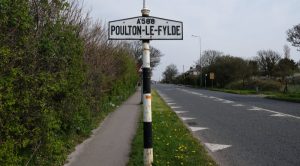
Image: Emma E. Threlfall/Shutterstock.com
Now you know a bit about it you will be anxious to pay it a visit. Well, the good news is it’s easy to get to.
By Train
Head For Poulton Le Fylde Station. It has good connections with Blackpool North, Manchester Picadilly and Preston on the West Coast Line.
Driving
The M6 is your friend here either from the north or south. Look for a turnoff for the M55 and then find the A585 or A588. Better still put FY3 0AP into your sat nav.
Got Five Minutes for Another Tour?
We love to create unique, interesting internet content here at Five Minutes Spare. We regularly update our list of town tours, so you might even find your UK home town in our list of places to visit. Take a day trip or go help the UK economy with a holiday. Whatever you do, do it with Five Minutes Spare.
Header Image: seeshooteatrepeat/Shutterstock.com
